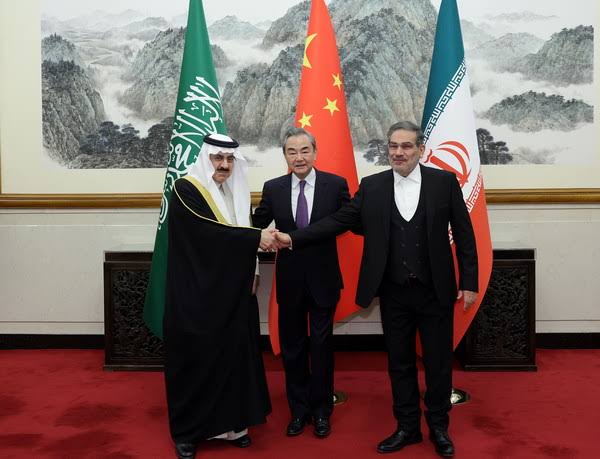The China-brokered deal heralds a new era in West Asia.
Saurabh Kumar Shahi
It’s a balmy February morning in the Middle East as the United States, with the UK in tow, brings together a motley group of countries to counter the influence of an upcoming superpower. Turkey, Iraq, Iran and Pakistan sign on the dotted lines as a militarily alliance takes shape. It is seen as a major diplomatic victory for the US as it entrenches itself in the region. The year is 1955 and the Baghdad Pact has come into being as an alliance against the Soviet Union.
Seven decades hence, in the same geographical extent, another big power raises its head and the erstwhile minions of the United States shake off the years of diplomatic slavery. As China brokers a deal between Saudi Arabia and Iran, the news comes as a bolt from the blue for both Washington and Tel Aviv – capitals left numb by the abject failure of their respective intelligence agencies to predict such an outcome.
Tehran and Riyadh have agreed to restore diplomatic relations after the successful culmination of the China-brokered talks. Analysts have given it many names from ‘thaw’ to ‘rapprochement’
Let’s first see what it carries. Riyadh and Tehran will restore diplomatic relations after seven years following a complete breakdown when, in retaliation to the execution of the Saudi Shia cleric Nimr al Nimr, protestors in Tehran stormed the Saudi embassy and did substantial damage. Saudis, and many of their subordinate allies, including Jordan, Egypt, Sudan and Bahrain, snapped diplomatic ties with Iran.
Now, the two countries have promised to uphold each other’s sovereignty and work on confidence-building measures.
The joint communiqué with China talks about certain “2001 Security Deal” and a “1998 Agreement” as the basis for further cooperation. This is an interesting titbit as both the agreements are comprehensive documents that would take years of effort to fully implement.
Security-led Deal
Let’s see the positives first and then venture into the choppy water. For starters, this appears to be a security establishment-led reconciliation because the final deal was negotiated between the National Security Advisors of both the countries and not the diplomats. It is also no coincidence that both the representatives have direct access to the respective supreme authority. While Ali Shamkhani has Ayatollah Khamenei’s ear, the Saudi NSA has been handpicked by Mohammad Bin Salman. And before Shamkhani came into the picture, it was his deputy, Saeed Iravani, who was leading the talks. It is good from the perspective of the security states that both Saudi Arabia and Iran are. Sources in Iran say that representatives from IRGC and Saudi military also had meetings on the sidelines in Beijing through the five-day duration of the main talks.
They also say that a lot of security issues were thrashed out before the deal was done. Chinese diplomats were hands-on and proactive for the entirety of the talks and no loose ends were left for future misinterpretation of the text.
Sources confirm that confidence-building measures have been agreed upon which build upon the previous CBMs struck in the last two years between the two parties. Under that deal, Riyadh had started issuing haj visas for Iranian pilgrims while Tehran refrained from appointing a new ambassador to Sana’a following the demise of Hassan Irlou who died of covid in 2021.
Who Gets What
Iran had seen growing isolation in the region in the last few years, especially following the Abraham Accords stuck by some of the Sunni regimes from the Persian Gulf and its peripheries. It also saw pressures on its diplomatic heft in Damascus where Persian Gulf states were seen falling over each other in warming up to President Assad. Turkey and Russia tried as well to cut Iran loose from the negotiations over Syria. While the effort failed, it made people in Tehran sit up and ponder over how much diplomatic capital they could afford to squander.
Yemen is also a big factor. Iran has been pumping large amounts of funds both in Syria and Yemen and it had become a bit unsustainable to continue with the same magnitude considering the pressing economic situation domestically. A stabilised Yemen and Syria would help Iran focus on Israel.
Saudis will also stop funding the anti-Iran Persian propaganda outlet ‘Iran International’ which was instrumental in the recent riots and unrest inside Iran. Saudis have also promised to cut off the Mojahedin-e-Khalq funding. Iran International has already packed its bags from London where it was based. Saudi support for Arab insurgent groups inside Iran’s Ahvaz region will also dwindle.
Economically too, Iran is getting direct benefits. On Saudi’s insistence, a large tranche of funds frozen inside Iraq and UAE will be unfrozen. UAE will pay Iran in Emirati Dirhams that Iran can use for purchases. China has also indicated that it will use its diplomatic heft to unfreeze Iranian funds in some of the countries in the Indochina region.
For Saudis, the benefits are endless. For starters, it will be offered a ladder to make a respectable climb down in Yemen where it has waged a disastrous war against Ansarullah. Saudis and Ansarullah have already thrashed out a deal in January. Though, the US and the UAE are against it.
UAE has slowly pushed the Saudis out of many areas where it once ruled the roost. Also, UAE’s alliance with Israel has seen both of them working together to colonise the strategic Yemeni islands of Socotra and Mayon, something Saudis are very uncomfortable with.
Under the circumstances, UAE and the US want a scenario in Yemen where it is partitioned into North and South Yemen. Both Saudis and Ansarullah will have none of it as they want united Yemen with centralised command. Saudis have also proposed a deal to Ansarullah where they get to control the northern areas as well as Sana’a while the rest of Yemen is split into four governorates of Aden, Hadramout, Marib and the Western Coast, each with a strong local government led by a coalition of leading tribes yet under the symbolic tutelage of the government in Sana’a. Sources say that Ansarullah has warmed up to this idea.
Behind the façade of the iron alliance, Saudis have started to get irritated with the UAE. The days of personal bonhomie between Mohammad Bin Sultan and Mohammad Bin Zayed are long gone. Riyadh is seething at the Emirati betrayal in Yemen and there is an emerging consensus inside the Saudi ruling class that the UAE has grown a little too big for its boots and a bit of trimming is required. This détente is an exercise towards that end too.
Saudis, free from the fear of getting struck by Iranian proxies in Iraq and Ansarullah, can focus on regaining their leadership position among the Sunnis where UAE is trying to make inroads, albeit with little success at this point. Sources also say that one of the commitments the Saudis made to the Iranians was that it would remain committed to the original Arab Peace Initiative which envisions the recognition of Israel only after the establishment of an independent Palestinian state. By making UAE jump that picket line and then not following through, Saudis are trying to make this issue a kryptonite for the Emiratis. While Saudi’s overtures to Israel are a reality, it has refrained from public posturing in that regard in contrast to the Emiratis, thereby leaving a room for plausible deniability.
The deal also helps Saudis and Iranians open an economic front against the UAE. UAE has benefitted from the sanctions on Iran as it has provided mechanisms to Tehran to bypass them at a price. In fact, out of the seven Emirates, Dubai’s and Ras-al-Khaimah’s economies depend a lot on this sanction-bypass trade with Iran. Saudis are likely to receive a big portion of this trade now from Iran in a big economic boost. Iranians also get an opportunity to become immune to the Emirati blackmail. This is over and above the direct economic loss the UAE shall face.
China and the Saudis are now planning a similar comprehensive deal between the GCC and Iran. With Saudis on board, Bahrain will most likely be the game. Iranians have a better relationship with Qatar, Oman and Kuwait. If a deal, even minus the UAE, is struck, Chinese diplomacy and Saudi stature will see a major boost. Iranian reset with Jordan and Egypt shall follow shortly.
No doubt the deal is being seen as a major shot in the arm for China. However, it is important here to mention two countries that tried to do the background work. At a much smaller level, Imran Khan-led Pakistani government tried to start a conversation between the two countries, however, a lack of ample diplomatic heft made it a nonstarter.
Iraq was more successful and most of the background work that led to this deal was done under the guidance of the then-Iraqi Prime Minister Mustafa al-Kadhimi. It is Iraq’s misfortune that Kadhimi’s successor al-Sudani did not show much interest in the process. Sources now say that Saudis asked President Xi Jinping to pick up this thread on his visit to Saudi Arabia earlier. He conveyed the message to President Raisi who welcomed the idea of Chinese mediation. China has the required diplomatic, financial and military might to negotiate such a deal. As a guarantor, it can use its economic and diplomatic power to punish the renegade party.
US on Sidelines
This has demonstrated to the audience far and wide that the US is now unable to bring two warring parties together, especially if it has a bad relationship with one of them. It doesn’t help either that it has a bad relationship with half the world. This should offer Europeans some food for thought that a Chinese-brokered peace in Ukraine will have more heft and credibility than the American shenanigans in the region. The question is, are the Europeans sovereign enough for such an effort?
Saurabh Kumar Shahi has covered The Greater Middle East for over 15 years and has reported from Kabul, Peshawar, Baghdad, Aleppo, Damascus, Beirut, and Jerusalem among other places.


